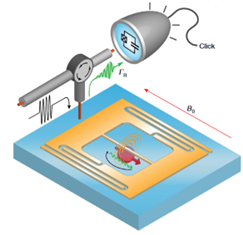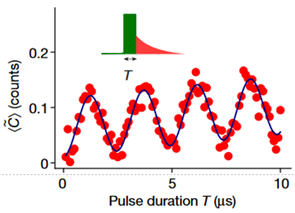Project 2
Quantum computing : Hardware
We are developing a new quantum computing architecture based on electron and nuclear spin impurities in solids. These naturally quantum systems exhibit long coherence times when embedded in an ultra-pure matrix, which makes them ideal qubits. The outstanding challenge is to interface them and read them out. Our original approach uses superconducting quantum circuits patterned on top of the crystal containing the impurities, which are coupled magnetically to the spins. We explore two related directions using this platform.
First, a large ensemble of spins can be used as a quantum memory to store the quantum state of superconducting qubits over long periods of time, in the form of propagating microwave photons. The memory is multi-mode and long-lived owing to the long spin coherence time. The interfacing with microwaves is achieved using frequency- and bandwidth-tunable superconducting resonators. In this platform, we recently achieved a spin coherence time of 0.5 seconds, using bismuth donors in isotopically-enriched silicon biased at their clock transition. The interface between the photons and the quantum memory is optimized analytically and using quantum control theory. This allows for a significant improvement in the efficiency of the devices both in “catching” the photon and in encoding and storing the many-spin ensemble states of the storage qubits.
Second, our platform also enables addressing individual electron spins coupled to a detection resonator, thanks to the use of an ultra-sensitive detector developed in our laboratory and called a Single Microwave Photon Detector (SMPD). We have recently demonstrated single-spin detection using erbium ions in a scheelite crystal of CaWO4 [1]. This result opens the way to a novel quantum computing architecture, based on nuclear spins coupled to the individual electron spins via the hyperfine interaction, and read-out via the SMPD.
[1] Single-electron spin resonance detection by microwave photon counting, Z. Wang, L. Balembois, M. Rančić, E. Billaud, M. Le Dantec, A. Ferrier, P. Goldner, S. Bertaina, T. Chanelière, D. Esteve, D. Vion, P. Bertet & E. Flurin, Nature 619, 276 (2023).

Principle of single-spin spectroscopy by microwave photon counting.

Characterization of spin s0. Rabi oscillation: measured average excess count (red dots) as a function of excitation pulse duration T (inset) and corresponding fit (solid line) by a sine function with linearly increasing offset. From [1]
Team for project 2
Patrice Bertet
CEA
Patrice Bertet
Felix Motzoi
FZJ
